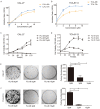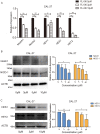FLI-06 Intercepts Notch Signaling And Suppresses The Proliferation And Self-renewal Of Tongue Cancer Cells
- PMID: 31571917
- PMCID: PMC6756372
- DOI: 10.2147/OTT.S221231
FLI-06 Intercepts Notch Signaling And Suppresses The Proliferation And Self-renewal Of Tongue Cancer Cells
Abstract
Purpose: The Notch signaling pathway plays an oncogenic role in tongue squamous cell carcinoma. The aim of this study was to inhibit the proliferation and self-renewal of tongue cancer cells by applying Notch signaling pathway inhibitor FLI-06 (Selleck, USA) and to lay a foundation for the clinically targeted treatment of tongue cancer for the future.
Methods: The mRNA expression level of Notch1 and the overall survival rate of patients with tongue cancer were examined by analyzing the TCGA database. Tongue cancer cells were treated with FLI-06. Cell proliferation, apoptosis, and stem cell self-renewal ability were tested in appropriate ways. A xenograft mouse model was established to observe tumor growth.
Results: From the TCGA data, we demonstrated that patients with high expression of Notch1 had a poor prognosis. We observed that the Notch signaling pathway inhibitor FLI-06 can restrain the activation of the Notch signaling pathway, decrease cell proliferation and induce cell apoptosis in vitro. The xenograft experiment indicated that intraperitoneal injection of FLI-06 inhibited tumor growth and increased cell apoptosis. FLI-06 suppressed both the mRNA and protein expression of Notch receptor and Notch targeted genes. We also observed that FLI-06 suppressed the proliferation of tongue cancer stem cells.
Conclusion: FLI-06 can block the proliferation and self-renewal of tongue cancer cells. It is inferred that this compound, which inhibits the Notch signaling pathway, may serve as a potential targeted drug for the treatment of tongue cancer in the clinic.
Keywords: Notch inhibitor; Notch signaling pathway; cancer stem cells; tongue cancer.
© 2019 Gan et al.
Conflict of interest statement
The authors report no conflicts of interest in this work.
Figures







Similar articles
-
Modulation of Notch Signaling by Small-Molecular Compounds and Its Potential in Anticancer Studies.Cancers (Basel). 2023 Sep 14;15(18):4563. doi: 10.3390/cancers15184563. Cancers (Basel). 2023. PMID: 37760535 Free PMC article. Review.
-
FLI-06 suppresses proliferation, induces apoptosis and cell cycle arrest by targeting LSD1 and Notch pathway in esophageal squamous cell carcinoma cells.Biomed Pharmacother. 2018 Nov;107:1370-1376. doi: 10.1016/j.biopha.2018.08.140. Epub 2018 Aug 31. Biomed Pharmacother. 2018. PMID: 30257352
-
Notch1 regulates tongue cancer cells proliferation, apoptosis and invasion.Cell Cycle. 2018;17(2):216-224. doi: 10.1080/15384101.2017.1395534. Epub 2017 Dec 21. Cell Cycle. 2018. PMID: 29117785 Free PMC article.
-
γ-Secretase Inhibitor, DAPT Inhibits Self-renewal and Stemness Maintenance of Ovarian Cancer Stem-like Cells In Vitro.Chin J Cancer Res. 2011 Jun;23(2):140-6. doi: 10.1007/s11670-011-0140-1. Chin J Cancer Res. 2011. PMID: 23482909 Free PMC article.
-
Notch Signaling in Breast Cancer: A Role in Drug Resistance.Cells. 2020 Sep 29;9(10):2204. doi: 10.3390/cells9102204. Cells. 2020. PMID: 33003540 Free PMC article. Review.
Cited by
-
Comprehending the crosstalk between Notch, Wnt and Hedgehog signaling pathways in oral squamous cell carcinoma - clinical implications.Cell Oncol (Dordr). 2021 Jun;44(3):473-494. doi: 10.1007/s13402-021-00591-3. Epub 2021 Mar 11. Cell Oncol (Dordr). 2021. PMID: 33704672 Review.
-
Modulation of Notch Signaling by Small-Molecular Compounds and Its Potential in Anticancer Studies.Cancers (Basel). 2023 Sep 14;15(18):4563. doi: 10.3390/cancers15184563. Cancers (Basel). 2023. PMID: 37760535 Free PMC article. Review.
-
Notch signaling in the pathogenesis, progression and identification of potential targets for cholangiocarcinoma (Review).Mol Clin Oncol. 2022 Mar;16(3):66. doi: 10.3892/mco.2022.2499. Epub 2022 Jan 19. Mol Clin Oncol. 2022. PMID: 35154706 Free PMC article. Review.
-
Notch signaling, hypoxia, and cancer.Front Oncol. 2023 Jan 31;13:1078768. doi: 10.3389/fonc.2023.1078768. eCollection 2023. Front Oncol. 2023. PMID: 36798826 Free PMC article. Review.
-
HPV+ve/-ve oral-tongue cancer stem cells: A potential target for relapse-free therapy.Transl Oncol. 2021 Jan;14(1):100919. doi: 10.1016/j.tranon.2020.100919. Epub 2020 Oct 24. Transl Oncol. 2021. PMID: 33129107 Free PMC article. Review.
References
-
- Dexter JS. The analysis of a case of continuous variation in drosophila by a study of its linkage relations. Am Nat. 1914;48(576):712–758. doi:10.1086/279446 - DOI
LinkOut - more resources
Full Text Sources

